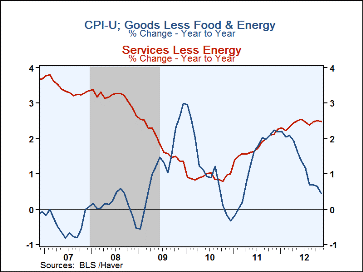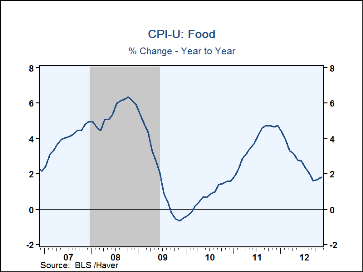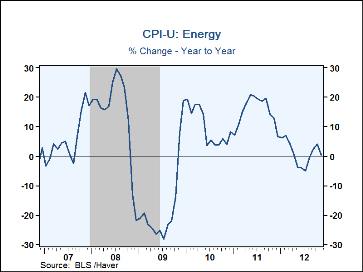 Global| Dec 14 2012
Global| Dec 14 2012U.S. Consumer Prices Move Lower With Another Drop In Energy Prices
by:Tom Moeller
|in:Economy in Brief
Summary
Consumers continue to see a decline in sellers' pricing power. The consumer price index for November fell 0.3% (+1.8% y/y) following a 0.1% October uptick. A 0.2% decline had been expected. The decline owed to a 4.1% drop (+0.3% y/y) [...]
Consumers continue to see a decline in sellers' pricing power. The consumer price index for November fell 0.3% (+1.8% y/y) following a 0.1% October uptick. A 0.2% decline had been expected. The decline owed to a 4.1% drop (+0.3% y/y) in energy prices which also were off 0.2% during the prior month. Food prices, however, rose again by 0.2% (1.8% y/y). Prices excluding food & energy ticked higher by 0.1%. That marginal gain brought the y/y increase down to 1.9% versus its peak of 2.3% reached in January.
Energy prices slumped 4.1% last month. The decline was led by a 7.4% drop in gasoline prices, which still were up 1.9% y/y. In addition, fuel oil prices slipped 0.2% (+2.6% y/y). Offsetting the energy price declines was another 0.2% increase in food prices led by a 0.8% gain (0.1% y/y) in dairy products. Meat, poultry & egg prices slipped 0.1% (+2.1% y/y).
Weaker pricing power extended itself to prices for other goods. These prices less food & energy fell 0.1% (+0.5% y/y), down for the fourth straight month. A 0.6% decline (+1.8% y/y) in apparel prices was accompanied by a 0.5% drop (-2.3% y/y) in used car prices. Appliance prices, however, rose by 0.7% (2.4% y/y) while prices for a new car or truck increased 0.2% (1.4% y/y). Household furnishings ticked up 0.1% (-0.1% y/y).
Core service prices increased another 0.2% and the y/y gain was stable at 2.5%. Shelter costs (32% of the CPI) increased 0.2% (2.2% y/y) as did owners equivalent rent of primary residences (2.1% y/y). This y/y increase compares to a low of -0.3% in early 2010. The monthly increase in public transportation prices of 0.8% (1.4% y/y) continued relatively strong while tuition costs rose another 0.4% (3.6% y/y) Recreation services prices increased 0.2% (3.2% y/y).
The consumer price data is available in Haver's USECON database while detailed figures can be found in CPIDATA. The expectations figure is from Action Economics and is found in the AS1REPNA database.
| Consumer Price Index(%) | Nov | Oct | Sep | Nov Y/Y | 2011 | 2010 | 2009 |
|---|---|---|---|---|---|---|---|
| Total | -0.3 | 0.1 | 0.6 | 1.8 | 3.1 | 1.6 | -0.3 |
| Total less Food & Energy | 0.1 | 0.2 | 0.1 | 1.9 | 1.7 | 1.0 | 1.7 |
| Goods less Food & Energy | -0.1 | -0.1 | -0.2 | 0.5 | 1.3 | 1.1 | 1.3 |
| Services less Energy | 0.2 | 0.3 | 0.3 | 2.5 | 1.8 | 0.9 | 1.9 |
| Food | 0.2 | 0.2 | 0.1 | 1.8 | 3.7 | 0.8 | 1.8 |
| Energy | -4.1 | -0.2 | 4.5 | 0.3 | 15.2 | 9.6 | -18.2 |
Tom Moeller
AuthorMore in Author Profile »Prior to joining Haver Analytics in 2000, Mr. Moeller worked as the Economist at Chancellor Capital Management from 1985 to 1999. There, he developed comprehensive economic forecasts and interpreted economic data for equity and fixed income portfolio managers. Also at Chancellor, Mr. Moeller worked as an equity analyst and was responsible for researching and rating companies in the economically sensitive automobile and housing industries for investment in Chancellor’s equity portfolio. Prior to joining Chancellor, Mr. Moeller was an Economist at Citibank from 1979 to 1984. He also analyzed pricing behavior in the metals industry for the Council on Wage and Price Stability in Washington, D.C. In 1999, Mr. Moeller received the award for most accurate forecast from the Forecasters' Club of New York. From 1990 to 1992 he was President of the New York Association for Business Economists. Mr. Moeller earned an M.B.A. in Finance from Fordham University, where he graduated in 1987. He holds a Bachelor of Arts in Economics from George Washington University.










